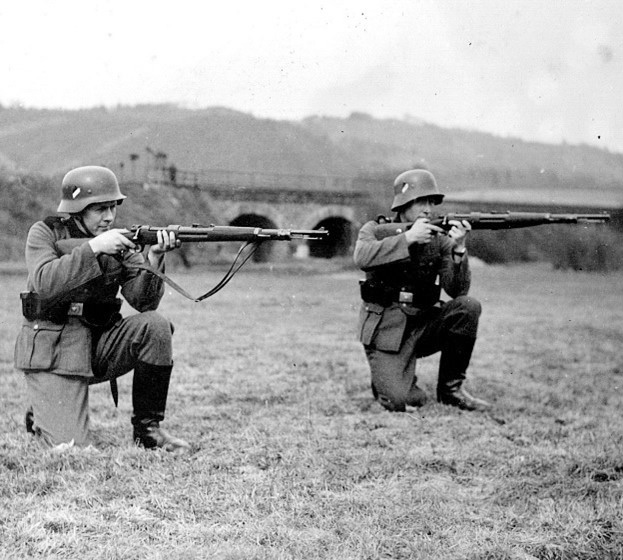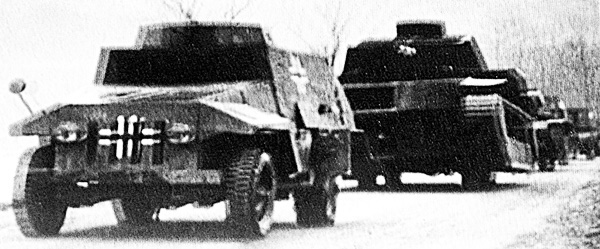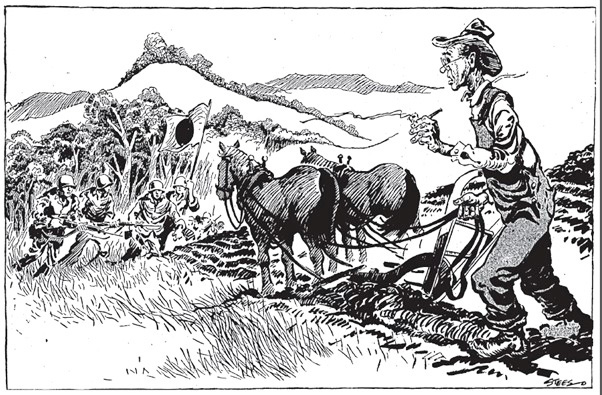Richard D. L. Fulton
(Adapted from ‘Nazis’ in Gettysburg: World War II Comes to a Civil War Battlefield by Richard D. L. Fulton, pending publication.)
It seemed like just another routine and ordinary morning in 1944 in tranquil Frederick and Adams counties to the casual observer, but something was about to occur which would be beyond the routine and the ordinary – perhaps even horrifying – in these rural counties.
As Mason-Dixon residents went about their normal business, perhaps starting their day at their kitchen tables having cups of coffee or enjoying their breakfasts and reading over their local newspaper on the events transpiring in a far-away war relegated in faraway places most Mason-Dixon residents would likely never see.
America was only a few months away from D-Day and the invasion of Normandy, but as many rural area farmers and their families went about their routine chores, a few of them might have noticed a disruption in the nearby tree lines, unusual activities in a distant field, or something not quite right about vehicles rumbling their way down a little-used dirt road.
Suddenly it became clear, as events began to transpire within more reasonable fields of vision, that the individuals who could be identified appeared to be armed men in uniforms – German Wehrmacht uniforms. At first a few individual German soldiers appeared, as if scouting, then squads and platoons began to walk out of the woods.
Before residents could decipher any meaning to it all, German armored vehicles could be seen rumbling along the rural roads. As the vehicles progressed closer, observers could observe the readily distinguishable and distinct Balkan crosses on the fronts and sides. Even more disturbing, two war planes – also bearing Balkan crosses on their wings and sides – could be seen flying low over the fields, as if scouting ahead of the converging enemy.
Slowly, as the unbelievable seemed to be unfolding before those who were observing the remarkable events, the sole reason behind it all could only suggest one thing – the unthinkable. The Germans were on the move, not in Europe, but in Maryland…in Frederick County, and making their way northward along the rural dirt byways, apparently, for all intents and purposes, completely undetected by any military authorities or local law enforcement.
How could this be? There had been no warning. Some of the local inhabitants might have been a little surprised, at least initially. There were, after all, several hundred members of the famed German Afrika Korps “encamped” just outside Gettysburg. Sure, they were just prisoners of war (referred to as PWs in that period of time) housed in the Gettysburg battlefield compound, but had the Wehrmacht launched a surprise raid on American soil to liberate them?
Several of the advancing Germans were “captured” by local farmers, who thought they could also be escaped prisoners of war and held them until they could be turned over to the military or police, but to their chagrin, their patriotic effort would ultimately have been as being proven to have been for naught. The farmers could make little sense of what their prisoners were trying to say – their captives, not surprisingly, could only speak German.
Certainly, to whatever local farmers and residents who might have been witnessing this seemingly unanticipated “invasion,” there must have been somewhat of a sigh of relief when groups of American GIs began to appear on the scene to essentially “save the day.”
Finally, after more than a week of apparent hit-and-run tactics having been employed by the Germans, triggering similar responses by the American troops at hand, the sounds of warfare began to taper off, until the only thing anyone within hearing distance might have heard were demands that the German forces surrender, being made by the Americans, spoken in German, and being broadcast from loudspeakers.
The American broadcasts announced to the Germans proclaimed that the Germans were surrounded, that resistance was futile, and that there was no sense dying when they could surrender and be treated in full accordance with the Geneva Convention.
As the invasion slowly began to grind to a halt as more groups of American troops began rounding up surrendering Germans and removing them from the scene—as well as liberating members of the enemy who had been taken into custody by shotgun-wielding locals.
Why had the infamous and renowned German Wehrmacht given up so easily? Perhaps the main reason was because this German “invasion” had not been plotted and orchestrated in Berlin. The planning for this “attack” on American soil began just outside of Gettysburg within a forested area of the old Gettysburg battlefield known as McMillan Woods, at a former Civilian Conservation Corps camp which had recently been re-dubbed by the military as “Camp George H. Sharpe” (see The Ritchie Boys” From Antietam to Gettysburg in the November issue of The Catoctin Banner).
The week-long invasion had been orchestrated as a training exercise for the approximately 800-man 2nd, 3rd, 4th, and 5th Mobile Radio Broadcasting companies, who would be responsible -upon deployment on D-Day – for attempting to coerce enemy troops into surrendering or retreating, and to spread factual information from behind enemy lines to the allies and generate “fake news” broadcasts to the enemy.
Because of the secretive nature of the exercises, the residents could not have been notified by the military in-advance, as it could have potentially jeopardized the covert nature of the operations emanating out of Camp Sharpe. The civilian population would not learn of the truth behind the invasion until after the close of the war.
As to the column of German vehicles, George Mandler recorded in Interesting Times: An Encounter With the 20th Century 1924 – that the shells of simulated German tanks were also constructed of plywood and mounted on Jeeps. Other types of German vehicles were nothing more than cardboard shells mounted on various other vehicles.
And as to the two German “Messerschmitt” fighters seen overhead during the engagement, The Baltimore Sun reporter Bready wrote that the simulated aircraft strafing was being recreated by two “Cub trainers, based at the Waynesboro airport.” Some of the German soldiers were actually German prisoners of war who had volunteered to participate in the maneuvers rather than just sit in PW camps.
But what about the distinct sounds of battle heard? The (Frederick) News reported in 1945, “speakers had been planted in strategic locations and used to broadcast actual combat noises.”
Making mention of the few German troops captured by local farmers, Hanna and Walter Kohner wrote in Hanna… Walter: A Love Story, “The German front was so carefully duplicated that some of the soldiers dressed in German uniforms not only were captured by our own units and interrogated, but also by some Gettysburg farmers, who took them for escaped POWs.”
Reporter Bready, jokingly referring to the farmer-captured Germans, stated, “Fun might be had counting up, in the hospital records at Ritchie, that cryptic entry, ‘Wound, buttocks, buckshot.”
Remnants of the “Nazi” Mason-Dixon Invasion still exist in the fields and woods of the affected woods and fields to this day. “The hills and forests surrounding the camp will be giving up souvenirs for years to come,” The (Frederick) News reported in 1945, a statement recently reinforced with the discovery of German World War II equipage and medals recovered by relic hunters at an undeveloped parcel of land off East Route 30, near Gettysburg.
Likewise, Sun reporter Bready wrote, “Long after the Jeep tracks and hoofprints are gone, the surrounding hills and forests will store up for future ages such memorials as C-ration cans, spent cartridges, and forsaken tent-pins.”
For additional information, see documentary “The Ritchie Boys”, Menemsha Films (menemshafilms.com).

Two German soldiers with rifles.

Source: Unpublished German photograph: Personal collection R. D. L. Fulton

Cartoon Source: The Baltimore Sun, December 16, 1945

